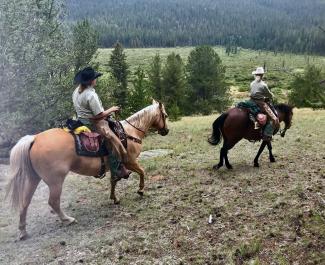Rangeland and Grazing
Rangeland Management on the PSICC
The Pike-San Isabel National Forests and Cimarron & Comanche National Grasslands participates in the development, implementation, and evaluation of rangeland projects including determining the need for plant community and watershed improvements, preparing livestock management plans and scheduling rangeland improvement projects. These improvement projects can vary from things such as fences, pipelines and cattle guards, to prescribed burning and vegetation management.
Between the two Grasslands, we administer five Grazing Agreements, manage grazing on more than 200 allotments and work with over 200 producers.

South Park Ranger District Range and Invasive Species Technician Vicki Russo and Natural Resources Specialist Sheila Lamb check a grazing allotment on the Pike-San Isabel National Forests & Cimarron and Comanche National Grasslands via horseback.
U.S. Forest Service photo by Chris SukachHistory
The Forest Service has undergone many changes in its management of rangelands. In the early 1800s, free forage on unclaimed public domain lands allowed the building of cattle and sheep empires. The ranges soon became over-grazed, overstocked, and overcrowded. Congress stepped in the early 1900s and designated the Forest Service as the pioneer grazing control agency. By 1906 to 1907, the Forest Service had established its system of range regulation. This includes permits, limits on herd size, grazing seasons, allotments, and rental fees. The system has served as a pattern for other agencies concerned with resource protection and the pursuit of society's goals. The Laws & Regulations web page provides more information about laws, regulations and policies directing Forest Service rangeland management.



